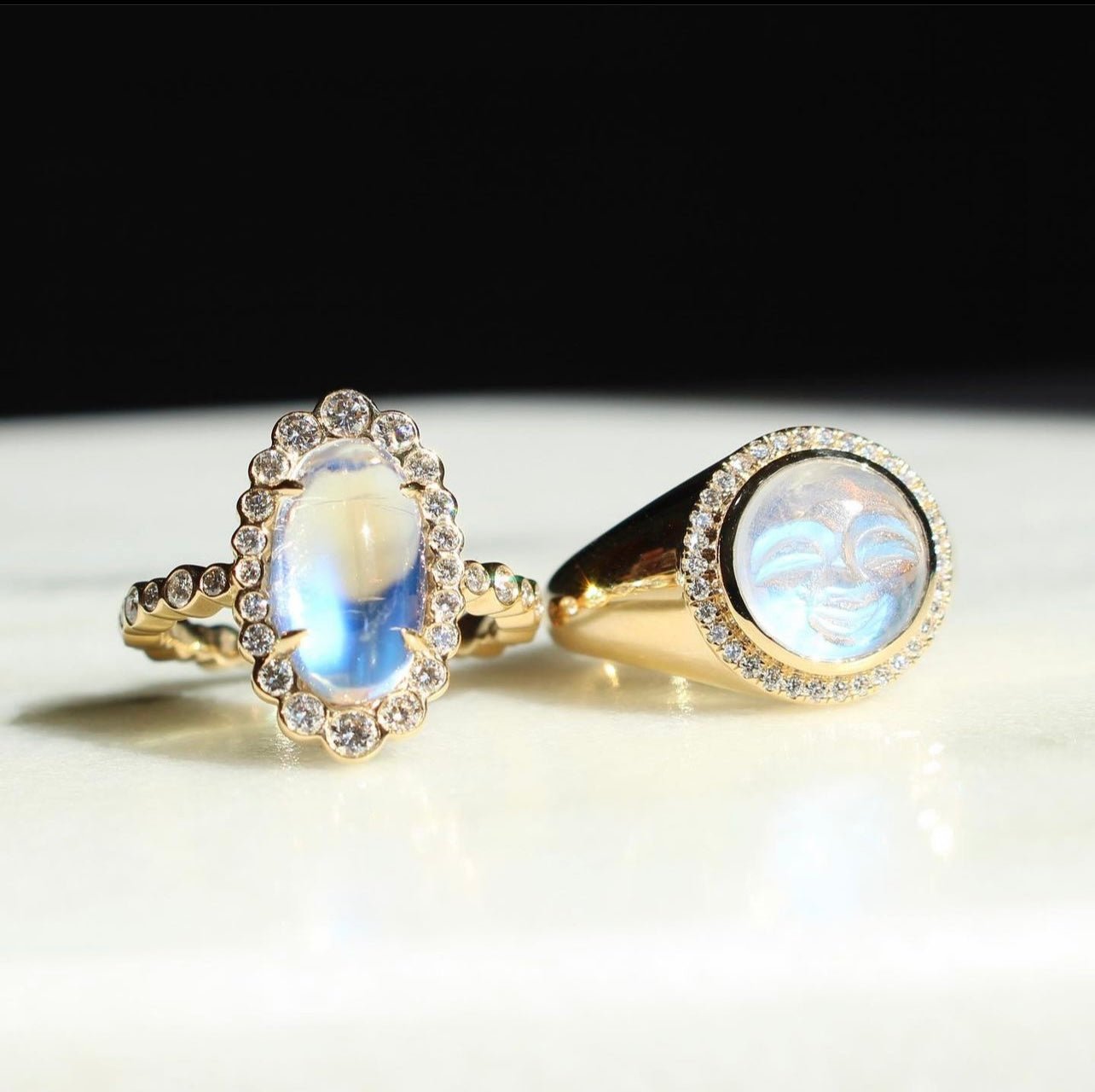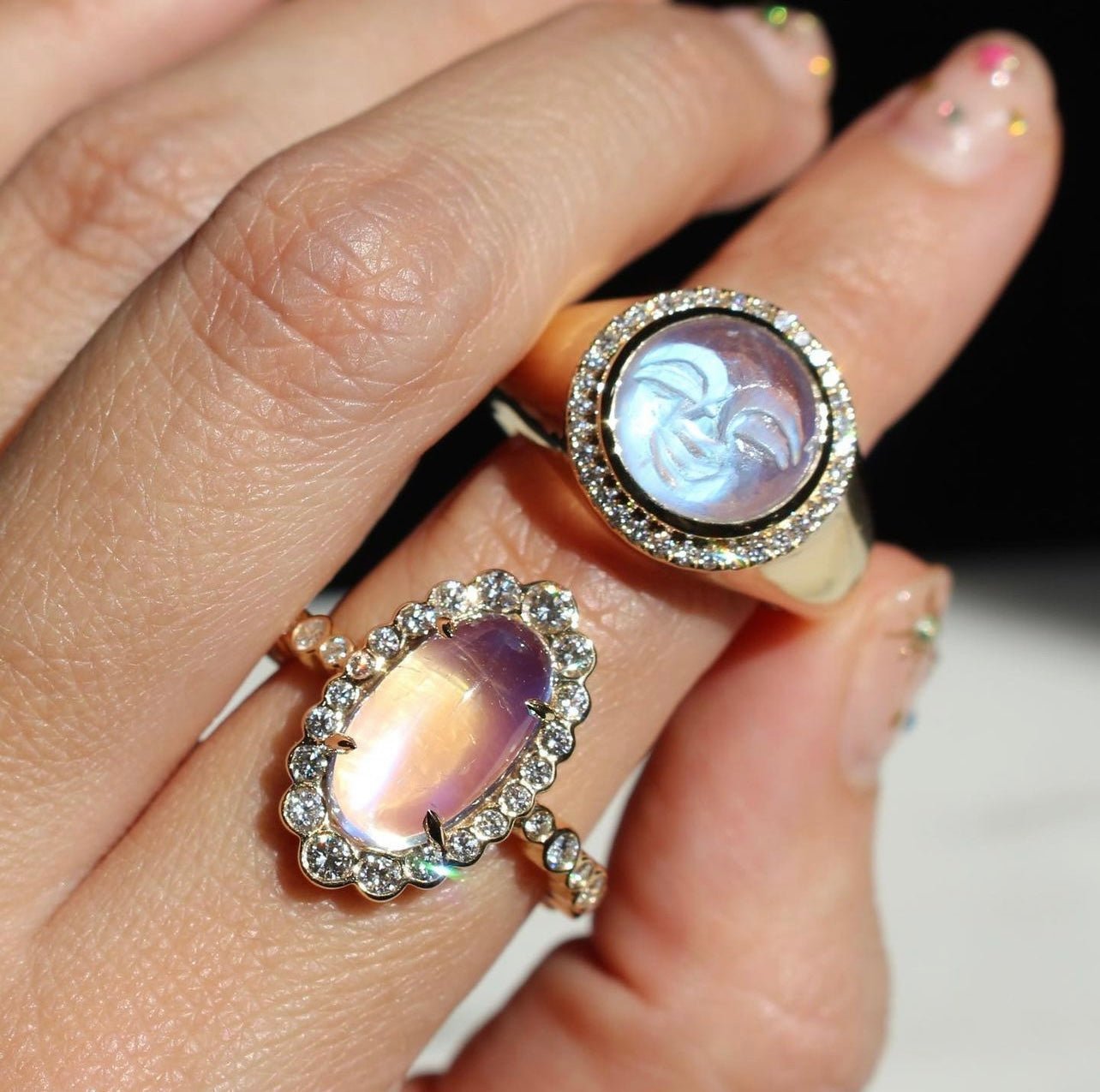There are numerous steps to picking out a brand new ring. Whether you’re focused on design, gemstone type, personalization, or quality, there will always be something to investigate. Often ring purchases coincide with big events, like proposals or anniversaries. They don’t only symbolize commitment, though; rings can be a great way to commemorate a birthday with special stones, too.
When you decide to incorporate stones into your ring, whether it's a diamond or a colorful gem, you have more decision-making to do. Stones can alter the appearance of the piece of jewelry altogether, depending not only on their size but on how big or small they appear in comparison to your finger.
In some cases, an exceptionally large diamond ring can be great for that flashy engagement staple you’ve always wanted. Other times, sticking with smaller stones makes the most sense if you work in a field where you’re likely to knock around your hands.
We certainly don’t want unnecessary scratches and cracks on beautiful stones! The key is a balance in proportions, making sure that you take your finger’s size into account before investing money into a piece.
The best way to settle on your ideal stone size is by following the markers of carat weight. What is the correlation between how heavy a stone is and how it looks? Let’s explore.
Weight and Width
Carats are a unit of weight measurement and are primarily utilized in relation to stones. You may be familiar with their inclusion in the hallmark 4Cs of diamond quality: color, clarity, cut, and carat. While they are listed last, this doesn’t diminish their importance to the overall appearance of the diamond (or of any stone). Carats are not exclusive to diamonds and are used to describe the weight of fine gemstones as well.
The carob seeds, hailing from Mediterranean and Middle Eastern trees, were used in ancient times to compare the weight of diamonds. A “carat” was equal to a “carob,” making them easy to balance on a scale. The old trick stuck, and carats were named after the seed pods. One carat is another way to say .2 grams (or .007 oz if you live in the U.S.).
Most fine diamonds and gemstones come in smaller sizes, especially when they have been properly cut. Specific cuts help to elevate the shine and sparkle in stones. They often need to be cut down from their raw material during the setting process, and this doesn’t diminish their overall quality, but it can lower their value in price (which is a good thing for consumers).
Dimensions Based on Carats
To put the size into perspective, a .5ct diamond is typically 5mm wide. A .8ct diamond is about 6mm, and a 1-carat diamond is 6.5. However, a 2-carat diamond (which would be exceptionally expensive if it was high quality) is 8mm wide.
There are some obvious discrepancies in the way that the width increases with carat weight. While width doesn’t tell the full story of a diamond, it is a good indicator of how large a stone may appear on your hand.
If you have a preference for a daintier stone, you could easily fluctuate between .4ct and .5ct or .6ct and .7 ct and not see much of a difference physically in size because they are so close in width.
Eye of the Beholder
The correspondence of carat weight to size can get trickier when you consider that a diamond, or any stone, is more than just its “top.” We perceive the outermost, faceted part of a stone as it is placed inside of a ring with the pointed piece facing downwards. We get the largest width up in front.
The heftier part of a stone is actually this lower portion that we can’t see easily. When stones of different weights are compared, it may look like they are quite similar in size when we don’t have access to the full picture.
It can be a blessing and a curse, a double-edged sword if you will. You’re paying more money for more carat weight and volume that you can’t see, but you’re also investing in a piece that will have more resale value in the future.
Measurements Matter
Before you jump into a carat weight that you love, you should consider the size of your hands and your fingers. If you’re shopping for a surprise engagement ring, we always recommend using an older piece of jewelry that fits the recipient as a guide. This ensures that you aren’t fumbling for a stone that may look off in dimension compared to someone’s ring size.
Measuring Ring Size at Home: How To
There are numerous ways to measure your own ring size. Once you know this information, your stone selection will become infinitely easier. Jewelers know just what carat weights result in exponentially different stone sizes and how they will look in relevance to your finger.
String Theory
One of the easiest ways to get your ring measurement is by bringing a piece of string around your finger where it meets the knuckle. Mark off how much of the string was used, and then lay this flat against a ruler. It is best to write how long the string section is in millimeters, even if you’re in the U.S.
Compare and Don’t Despair
You can also take a ring that you know fits you best, just like we mentioned for those who are sneaking away with surprise ring gifts and align it on a ring size chart. This may be a little less accurate if the ring is too tight or too loose on your hand — always go for a bigger fit, so nothing gets stuck! It is much better to be safe than sorry. No matter what, it’s always best to keep a ring dish on hand so that if you need to slide your ring off, it will never get lost.
Average Ring Sizes in the United States
Once you have your rough mm measurement, look at a ring chart. The average female ring size in the U.S. is six, and the average male size is 11. However, the sizes range from three to nine and eight to 14, respectively. While most pre-sized rings are found in gendered sizes, if you have larger or smaller fingers than most, make a note of this and plan to get your ring specially sized.
Ring Size vs. Stone Width
The good news is that ring sizes and stone width are both written in mm. This makes your life a lot easier when it comes to figuring out what weight to get because you only need to convert from mm to carats once.
A size six ring is 16.5mm, and a size 11 ring is 20.6mm. Since we know that a 2-carat ring is about 8mm, less than half of the width of a size six band, you can rest assured that bigger carats are fair game for the average size.
Two carats do not look “massive,” but you may want to skew for a lesser carat stone if you have, for example, a size two ring. This prevents the stone from looking lopsided in its setting and on your finger.
Many women in the U.S. have an engagement ring with a diamond (or other stone) that is between 0.5 and 1 carat. Many others have an engagement ring that features a stone between 1 and 1.5 carats.
The jump from 1 carat to 1.5 carats in mm is only 1.5 (from 6.5mm to 7.5mm), but the price nearly doubles.
Go With Your Gut
If you have always dreamed of having the largest diamond ring possible, then don’t let your finger size stop that dream. At Mark Henry Jewelry, we believe that everyone can rock whichever stone they’ve fallen in love with.
It is just best to be mindful of whether or not the ring may feel too heavy on your hand or not be easy to wear every day. A smaller stone can be just as elegant in its simplicity.
Make It Count
If you do go with a higher carat stone, ensure that it is still high quality in all other areas (color, cut, and clarity). A colorless, flawless, brilliant cut diamond will be well worth the price regardless of its size. Choose wisely, and you can shine brightly.
Sources:
Understanding Diamond Carat Weight | American Gem Society

